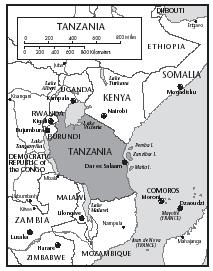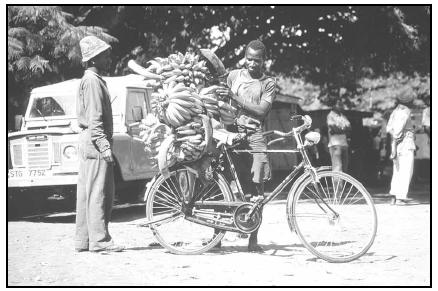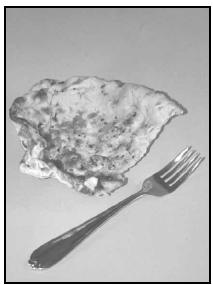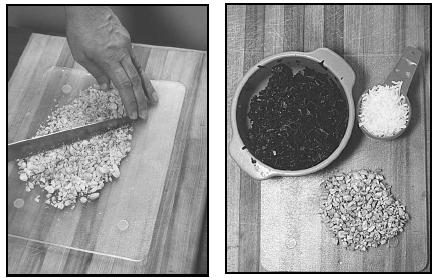Tanzania
Recipes

1 GEOGRAPHIC SETTING AND ENVIRONMENT
Situated in East Africa just south of the equator, Tanzania is made up of a mainland area and the islands of Zanzibar, Pembe, and Mafia. Mainland Tanzania lies between the area of the great lakes—Victoria, Tanganyika, and Malawi (Niassa)—and the Indian Ocean. It contains a total area of 945,090 square kilometers (364,901 square miles), slightly larger than twice the size of the state of California. A plateau makes up the greater part of the country. The Pare mountain range is in the northeast, and the Kipengere mountain range is in the southwest. Mt. Kilimanjaro (5,895 meters/19,340 feet) is the highest mountain in Africa. On the borders are three large lakes: Victoria, Tanganyika, and Lake Malawi.
Two-thirds of Zanzibar Island consists of low-lying coral country covered by bush and grass plains. The western side of the island is fertile, and Pemba, apart from a narrow belt of coral country in the east, is fertile and densely populated.
There are four main climatic zones: the coastal area and immediate interior, where conditions are tropical; the central plateau, which is hot and dry; the highland areas; and the high, moist lake regions.
2 HISTORY AND FOOD
The earliest known inhabitants in Tanzania's long and colorful past were primarily hunter-gatherers. In addition, Tanzania has had many of years of influence from other parts of the world. In the first five hundred years A.D., vegetables, millet, and sorghum, and fruits and fish were mostly eaten. By A.D. 800, however, Muslim Arabs established trade routes to and from the country. They introduced citrus fruits, cotton plants,

Portuguese explorer Vasco da Gama arrived in East Africa in 1498 and aggressively took control of the coastal regions and trade routes. Da Gama (called afriti , a devil, by locals), who was on his way to the Middle East and India, stopped at present-day Tanzania to rest his men, who were suffering from scurvy (a lack of vitamin C). Chungwa (oranges, rich in vitamin C), relatively unknown to Europeans at the time, were introduced to the ailing crewmen. The Portuguese dominated the region until the Arabs regained control in 1698. Despite nearly two hundred years of rule, the Portuguese left little behind. The introduction of cassava, a root crop that has become an important staple in the Tanzanian diet, and groundnuts (peanuts) were probably their most significant contributions.
The number of East African slaves who were bought to work Tanzania's plantations increased as the result of the discovery of clove, a key spice in the country's cuisine. After slavery was abolished in 1873, the British and Germans battled for control over Tanzania (then known as Tanganyika). At first, the British (who introduced tea and boiled vegetables) prevailed, encouraging the cultivation of crops that could be exported for profit. By 1891, the Germans took control. They established coffee and cotton plantations. The success of the plantations, however, diminished during World War I (1914–1918), when nearly 100,000 troops and civilians died as a result of fighting, influenza (flu), and famine. Tanzania became an independent nation on December 9, 1961.
Chai (Tea)
Ingredients
- 3 to 4 cups water
- 3 to 4 cups milk
- 3 to 4 teaspoons tea (plain black is best)
- Cardamom, ground
- Ginger, ground
- Sugar
Procedure
- Combine all the ingredients together in a large saucepan.
- Add a few pinches of cardamom and a pinch of ginger.
- Bring the mixture to a low boil and simmer for a few minutes.
- Strain the tea into a teapot and serve immediately.
Coconut Bean Soup
Ingredients
- 1 Tablespoon oil
- ½ cup onions, chopped
- ½ cup green peppers, chopped
- 1 teaspoon curry powder
- 1 teaspoon salt
- ¼ teaspoon pepper
- 3 Tablespoons butter or margarine, softened
- 1 cup fresh tomato, seeded and cut into chunks
- 2½ cups canned kidney beans with liquid (or black-eyed peas)
- 2 cups coconut milk
- 3 cups water
- ½ cup cooked rice
- ½ cup shredded coconut
Procedure
- In a large saucepan, heat the oil and sauté the onions until softened.
- Add green peppers, curry powder, salt, pepper, butter or margarine, and tomato, and simmer for 2 minutes.
- Add the kidney beans with their liquid, the coconut milk, and water.
- Simmer gently for 10 minutes, Stir in the cooked rice and heat for about 2 minutes.
- Ladle into bowls. Top each serving with 1 Tablespoon of shredded coconut, and serve.
Serves 8 to 10.
3 FOODS OF THE TANZANIANS
Most food that makes up Tanzanian cuisine is typical throughout all of East Africa. Meat is not widely consumed in comparison with other areas of the continent. Cattle are normally slaughtered only for very special occasions, such as a wedding or the birth of a baby. Cattle, sheep, and goats are raised primarily for their milk and the value they contribute to social status. When meat is consumed, however, nyama choma (grilled meat) and ndayu (roasted, young goat) are most popular.
The Tanzanian diet is largely based on starches such as millet, sorghum, beans, pilaf, and cornmeal. A meal that could be considered the country's national dish is ugali , a stiff dough made of cassava flour, cornmeal (maize), millet, or sorghum, and usually served with a sauce containing either meat, fish, beans, or cooked vegetables. It is typically eaten out of a large bowl that is shared by everyone at the table. Wali (rice) and various samaki (fish) cooked in coconut are the preferred staples for those living in coastal communities.
The introduction of various spices by the Arabs is highly evident in a popular coastal dish, pilau . It consists of rice spiced with curry, cinnamon, cumin, hot peppers, and cloves. Matunda (fruits) and mboga (vegetables) such as plantains, similar to the banana, ndizi (bananas), pawpaw (papaya),

Chai (tea), the most widely consumed beverage, is typically consumed throughout the day, often while socializing and visiting with friends and family. Sweet fried breads called vitumbua (small rice cakes) are commonly eaten with chai in the mornings, or between meals as a snack. Chapatti (fried flat bread), also served with tea, is a popular snack among children. Street vendors commonly sell freshly ground black coffee in small porcelain cups, soft drinks, and fresh juices made of pineapple, oranges, or sugar cane. Adults enjoy a special banana beer called mbege made in the Kilimanjaro region (northeast Tanzania). Aside from the common serving of fresh fruits or pudding, desserts such as mandazi (deep-fried doughnut-like cakes) are sold by vendors.
Ugali
Ingredients
- 2 to 3 cups white cornmeal (cornmeal grits, farina, or cream of wheat may be substituted)
- 2 cups water
Procedure
- Heat water in a saucepan until boiling.
- Slowly pour in cornmeal, continuously stirring and mashing the lumps.
- Add more cornmeal until it is thicker than mashed potatoes (It may resemble Play Dough consistency.) Cook for 3 or 4 minutes and continue to stir.
- Serve immediately with any meat or vegetable stew, or any dish with a sauce or gravy.
- To eat the ugali, a small amount of dough is torn off, shaped into a ball with a dent in it, and then used to scoop up meat, vegetables, or sauce.

Chapatti (Fried Flat Bread)
Ingredients
- 2 cups flour
- Warm (almost hot) water
- Pinch of salt
- 1 onion, finely chopped
- Cooking oil
Procedure
- With very clean hands, mix the flour, salt, and chopped onion with enough hot water to make a smooth, elastic dough.
- Coat the ball of dough with oil and roll flat on a floured surface until about ½-inch thick.
- Cut the dough into ½-inch wide strips.
- Roll the strips of dough into spirals and let them rest on a floured surface.
- Roll each spiral into a round, flat pancake, about ¼-inch thick.
- Cook over a medium to high heat griddle or frying pan.
- Fry the first side without oil, just until the dough sets.
- Turn over and lift one side enough to pour 1 teaspoon of cooking oil underneath.
- Turn and press the chapatti gently into the oil, with the back of a spoon, so it absorbs the oil evenly and fries to a light golden color. Turn just once.
- The chapatti should be soft and supple when finished.
Makes about 8 chapatti.
Mango-Orange Drink
Ingredients
- 3 cups water
- ½ cup sugar
- 1 Tablespoon orange peel, grated
- 2 cups mango, mashed
- 1 cup orange juice, fresh
- ½ cup lemon juice, fresh
Procedure
- Heat the water with the sugar and orange peel over low heat until the sugar is dissolved.
- Cool down to room temperature.
- Add the mango flesh and the orange and lemon juices and mix well. Serve cold.
Makes about 2 quarts.
Ndizi Kaanga (Fried Bananas or Plantains)
Ingredients
- 8 whole plantains or green bananas, peeled
- Lemon juice
- Brown sugar (optional)
- Butter, melted
- Nutmeg
Procedure
- Melt butter in a frying pan.
- Cut and quarter the bananas or plantains.
- Dip the banana pieces in lemon juice and place them in the buttered frying pan.
- Lightly brown, remove, and drain on paper towels. Sprinkle with nutmeg and brown sugar, if desired. ( Ndizi is typically not sweetened in Tanzania.)
Serves 8 to 10.
Wali wa Nazi (Rice in Coconut Milk)
Ingredients
- 2 cups rice
- 1 can coconut milk plus water to make 4 cups of liquid
- 1 teaspoon salt
Procedure
- Measure 4 cups of liquid (coconut milk and water) into a saucepan.
- Add 1 teaspoon salt. Heat the liquid until it boils.
- Stir in 2 cups rice. Lower heat, cover, and simmer until all the liquid is absorbed (about 25 minutes).
- Serve hot alone or to accompany a main dish.
Serves 8 to 10.
4 FOOD FOR RELIGIOUS AND HOLIDAY CELEBRATIONS
The people of Tanzania follow a variety of religions. Roughly one-third of the population is Muslim (believers in Islam) and one-third is Christian. Nearly all of the island of Zanzibar and much of the mainland coastal regions consist of Muslims; most Christians live inland. Hinduism and indigenous beliefs make up the majority of the remaining one-third who believe in a specific religion.
The warm Christmas in Tanzania is a special time for Christians. The majority of people are invited to a guest's house for dinner Christmas night. Pilau (rice dish containing spices), chai , and a chicken, red meat, or seafood dish are usually served. A traditional walk along the beach following dinner may leave some very wet—Christmas falls during East Africa's rainy season.
Ramadan is probably the holiest time of the year for Muslims. During this month-long observance, neither food nor drink may be consumed between sunrise and sunset, often a difficult responsibility in the country's warm temperatures. Eid al-Fitr , the feast that ends the month of fasting, is always eagerly anticipated by Muslims of all ages. In expectation of the feast, vendors sell cassava chips and tamarind juice made from the tamarind (a flat, bean-like, acidic fruit), and some rush to the stores to purchase plantains, fish, dates, and ready-made bags of ugali for the long-awaited meal. To make certain the feast can take place (and that Ramadan has ended), many gather around to listen to the radio, hoping to hear that the new moon has officially arrived in the night sky. When it is announced, children often dress up (similar to Halloween in the United States) and walk from house to house for cake and lemongrass tea.
Secular (nonreligious) holidays also produce a lot of excitement. On August 8 each year, Farmers and Peasants Day is celebrated. On this day, the country pays tribute and expresses appreciation to farmers and peasants for helping to feed the country and keep agriculture thriving. Zanzibar, one of the country's islands, has its own celebration every January 12, marking the anniversary of the island's independence from Britain.
A Typical Christmas Dinner Menu
Pilau (rice mixed with a variety of spices)
Chicken, grilled lamb, or seafood cooked in coconut
Beans or eggplant
Fresh fruit
Rice or potato pudding
Chai (tea)
On the special day of a Tanzanian wedding, gifts are often given to the bride-to-be by her family so that she is prepared to cook and care for her new husband. A kinu (wooden mortar for crushing grains and vegetables), a kibao cha (coconut grater), a kebao cha chapatti (round table for preparing chapatti ), and a upawa (wooden ladle) are examples of traditional gifts. On such a special occasion, mbuzi (roasted goat) is often prepared.
Supu Ya Ndizi (Plantain Soup)
Ingredients
- 2 or 3 (1 pound) green plantains, peeled
- 6 cups chicken broth (3 cans of chicken broth may be used)
- Salt and pepper, to taste
Procedure
- Slice the peeled plantains and put them into a blender or food processor with 1 cup of the chicken broth.
- Blend them together until smooth and free of lumps.
- Pour the remaining 5 cups of chicken broth into a large saucepan. Stir in blended plantain mixture.
- Cover and cook over medium heat, stirring occasionally, until soup is thickened (about 45 minutes). Add salt and pepper to taste.
Serves 8 to 10.
Date Nut Bread
Ingredients
- 1 cup dates, chopped
- 1 cup boiling water
- 1 teaspoon baking soda
- ¾ cup sugar
- 5 Tablespoons butter
- 1 egg
- ½ teaspoon salt
- 2 cups flour
- ½ cup nuts, coarsely chopped
- 1 teaspoon vanilla extract

Procedure
- Preheat oven to 325°F.
- Boil the water in a saucepan and place the dates and baking soda in a bowl.
- Pour the boiling water over the dates and baking soda, stir, and let cool.
- In a separate bowl, cream together the sugar, butter, and egg.
- Add the salt and flour gradually to the butter mixture.
- Add vanilla, nuts, and the date/baking soda mixture. Stir to combine.
- Pour batter into a buttered loaf pan and bake for about 45 minutes, or until golden and the top springs back when touched.
Serves 10 to 12.
Sweet Potato Pudding
Ingredients
- 6 medium-size sweet potatoes (about 2 pounds), peeled and cut into ½-inch cubes
- 3 cups milk
- 1 cup heavy cream
- ½ cup sugar
- ½ teaspoon saffron, ground
- ½ teaspoon cardamom, ground (optional)
Procedure
- Bring 1 quart of water to a boil in a saucepan.
- Drop in the sweet potatoes and cook, uncovered, for 25 to 30 minutes, or until the potatoes are tender (can be piered with a fork).
- Drain in a colander and return potatoes to the pan.
- Stir in the milk, cream, sugar, saffron, and cardamom.
- Heat slowly to boiling over medium-low heat, stirring frequently with a wooden spoon.
- Reduce the heat to low, stirring from time to time, and simmer uncovered for about 1 hour, or until the potatoes are reduced to a puree and the mixture is thick enough to hold its shape.
- With the back of a spoon, rub the pudding through a fine sieve into a serving bowl.
- Serve at room temperature or refrigerate for 2 hours.
- Just before serving, sprinkle the top with additional cardamom, if desired.
Serves 6 to 8.
5 MEALTIME CUSTOMS
Guests are polite and respectful when visiting a Tanzanian home. Loose-fitted clothing is appropriate attire, since most meals are served to diners seated around a floor mat or low table. Prior to the meal, a bowl of water and a towel may be passed around to the diners to wash their hands. The bowl is passed to the next person with the right hand, as the left one is considered unclean. The right hand should also be used to dip into the ugali , which is commonly served in a communal bowl before the main meal.
Goat, chicken, or lamb is likely to be served, for those who can afford it. Most families eat meat only on special occasions, such as a wedding. A wali (rice) dish and a vegetableor maharage (beans), may also be served along with chai (tea). Greens are popular side dishes, and are often prepared with coconut and peanuts (Mchicha) or tomatoes and peanut butter (Makubi). Fresh fruit is the most common after-dinner treat, although sweets such as honey or potato cakes may also be offered. It is acceptable to leave food on a plate at the end of a meal, as this reassures the host that the guest is satisfied.
Eating customs vary throughout the country according to ethnic group and religious beliefs. However, the typical family meal is almost always prepared by the mother and daughters, usually on a wood or charcoal fire in an open courtyard, or in a special kitchen that is often separated from the rest of the house. The midday meal is usually the largest, consisting of ugali, spinach, kisamuru (cassava leaves), and stew, though kiamshakinywa (breakfast) is seldom forgotten. Spiced milk tea and freshly baked bread are popular in the morning. Men and women in Muslim households (about one-third of Tanzanians) often eat separately. Taboos may also prohibit men from entering the kitchen at all.
Only a little over half of all children in Tanzania attend primary school, according to UNICEF. As an added incentive to attend school, foreign countries (such as the United States) are helping to offer free lunches to students during the day. The Tanzania School Health Program aims to ensure child health, including the maintenance of clean water and periodic physical examinations. In addition, the program promotes the growth of school gardens to assist in nutritional education. A typical Tanzanian school lunch may be porridge made of millet, groundnuts (peanuts), and sugar, cooked outside in large kettles over an open fire, often accompanied by milk.
Mchicha (Spinach, Coconut, and Peanuts)
Tanzanians often prepare spinach as a side dish.
Ingredients
- 4 Tablespoons butter
- 2 packages (12 ounces each) frozen chopped spinach, thawed
- ½ cup coconut, grated
- ½ cup peanuts, finely chopped
Procedure
- In a 2-quart saucepan, melt the butter and add the 2 packages of thawed spinach, grated coconut, and chopped peanuts.
- Toss lightly until the ingredients are combined, heated through, and all the liquid is absorbed. Add salt and pepper, if desired.
- Serve as a vegetable with any meat, poultry, or fish dish.
Serves 8.
Makubi
This dish combines spinach with tomatoes and creamy peanut butter.
Ingredients
- 2 packages frozen spinach, thawed (or 2 cups fresh)
- 1 can (16 ounces) tomatoes, chopped
- Salt, to taste
- ½ cup smooth peanut butter
Procedure
- Combine the 2 packages (or 2 cups fresh) spinach and can of chopped tomatoes in a saucepan and heat until bubbly. Add salt to taste.
- Stir in peanut butter and continue cooking over low heat until heated through. Serve.
Serves 8.
6 POLITICS, ECONOMICS, AND NUTRITION
About 40 percent of the population of Tanzania is classified as undernourished by the World Bank. This means they do not receive

Tanzania is one of the world's poorest countries and undernourishment is prevalent, especially in children. The young life expectancy age of 42.3 years is mostly due to malnutrition, tropical diseases such as malaria, and very unsanitary conditions. Open sewers, uncovered garbage piles, and contaminated streams and lakes are sources of disease. Although living conditions in larger towns and cities are typically better than in rural areas, unsanitary conditions and malnourishment are widespread throughout both. Childhood deficiencies in Vitamin A (which can cause blindness) and iodine are the country's most serious malnourishments.
7 FURTHER STUDY
Books
Asch, Lisa. Tanzania . Lincolnwood, Illinois: NTC/Contemporary Publishing Company, 1997.
Camerapix Publishers International. Spectrum Guide to Tanzania . New York: Interlink Publishing Group, Inc., 1998.
Frey, Elke and Kavid Kyungu. Explore the World: Tanzania . München: Nelles Verlag, 1998.
Lauré, Jason and Ettagale Blauer. Tanzania . Canada: Children's Press, 1994.
Tanzania, Zanzibar & Pemba . Victoria, Australia: Lonely Planet Publications, 1999.
Webb, Lois Sinaiko. Holidays of the World Cookbook for Students . Phoenix, AZ: The Oryx Press, 1995.
Web Sites
CultureConnect.com. [Online] Available http://cultureconnect.com/content/travel/gemma1-1.htm (accessed April 4, 2001).
Life in Africa. [Online] Available http://www.lifeinafrica.com/fun/recipes/chapati.htm/ (accessed April 3, 2001).
Recipes of Africa. [Online] Available http://www.balaams-ass.com/journal/homemake/rcpafras.htm (accessed April 3, 2001).
Sallys-Place.com. [Online] Available http://www.sallys-place.com/ (accessed April 3, 2001).
The Swahili Coast Magazine. [Online] Available http://www.swahilicoast.com/ (accessed April 5, 2001).
Unicef. [Online] Available http://www.unicef.org (accessed April 3, 2001).
Zanzibar.org. [Online] Available http://www.zanzibar.org (accessed April 5, 2001).
I trust that you are keeping well.
Kindly can you let me know where I can get cassava flour in bulk in Tanzania. Any assistance will be appreciated.
Thank you and hope to hear from you soon.
Regards
Lise